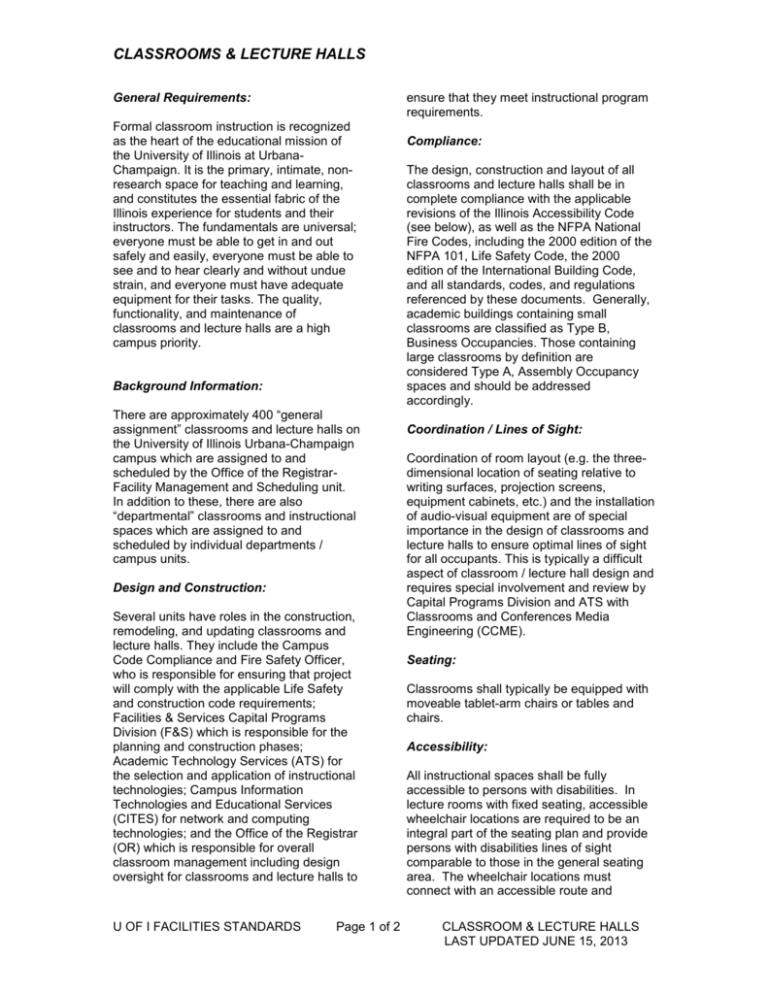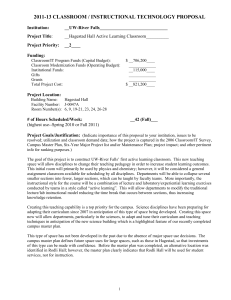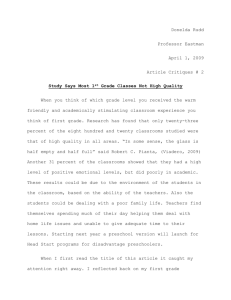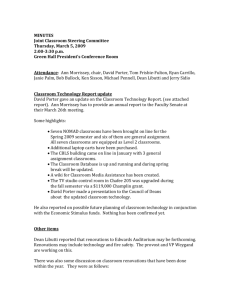Classroom Lecture Halls General Design
advertisement

CLASSROOMS & LECTURE HALLS General Requirements: ensure that they meet instructional program requirements. Formal classroom instruction is recognized as the heart of the educational mission of the University of Illinois at UrbanaChampaign. It is the primary, intimate, nonresearch space for teaching and learning, and constitutes the essential fabric of the Illinois experience for students and their instructors. The fundamentals are universal; everyone must be able to get in and out safely and easily, everyone must be able to see and to hear clearly and without undue strain, and everyone must have adequate equipment for their tasks. The quality, functionality, and maintenance of classrooms and lecture halls are a high campus priority. Background Information: There are approximately 400 “general assignment” classrooms and lecture halls on the University of Illinois Urbana-Champaign campus which are assigned to and scheduled by the Office of the RegistrarFacility Management and Scheduling unit. In addition to these, there are also “departmental” classrooms and instructional spaces which are assigned to and scheduled by individual departments / campus units. Design and Construction: Several units have roles in the construction, remodeling, and updating classrooms and lecture halls. They include the Campus Code Compliance and Fire Safety Officer, who is responsible for ensuring that project will comply with the applicable Life Safety and construction code requirements; Facilities & Services Capital Programs Division (F&S) which is responsible for the planning and construction phases; Academic Technology Services (ATS) for the selection and application of instructional technologies; Campus Information Technologies and Educational Services (CITES) for network and computing technologies; and the Office of the Registrar (OR) which is responsible for overall classroom management including design oversight for classrooms and lecture halls to U OF I FACILITIES STANDARDS Page 1 of 2 Compliance: The design, construction and layout of all classrooms and lecture halls shall be in complete compliance with the applicable revisions of the Illinois Accessibility Code (see below), as well as the NFPA National Fire Codes, including the 2000 edition of the NFPA 101, Life Safety Code, the 2000 edition of the International Building Code, and all standards, codes, and regulations referenced by these documents. Generally, academic buildings containing small classrooms are classified as Type B, Business Occupancies. Those containing large classrooms by definition are considered Type A, Assembly Occupancy spaces and should be addressed accordingly. Coordination / Lines of Sight: Coordination of room layout (e.g. the threedimensional location of seating relative to writing surfaces, projection screens, equipment cabinets, etc.) and the installation of audio-visual equipment are of special importance in the design of classrooms and lecture halls to ensure optimal lines of sight for all occupants. This is typically a difficult aspect of classroom / lecture hall design and requires special involvement and review by Capital Programs Division and ATS with Classrooms and Conferences Media Engineering (CCME). Seating: Classrooms shall typically be equipped with moveable tablet-arm chairs or tables and chairs. Accessibility: All instructional spaces shall be fully accessible to persons with disabilities. In lecture rooms with fixed seating, accessible wheelchair locations are required to be an integral part of the seating plan and provide persons with disabilities lines of sight comparable to those in the general seating area. The wheelchair locations must connect with an accessible route and CLASSROOM & LECTURE HALLS LAST UPDATED JUNE 15, 2013 CLASSROOMS & LECTURE HALLS accessible means of egress. An accessible route shall connect the wheelchair seating locations with the instructor’s station or presentation area. All instructional furniture, writing surfaces, and instructional media controls shall be designed and located so as to be accessible to persons with disabilities. At least one companion seat (fixed or readily removable) shall be located next to each wheelchair seating area. In addition, one percent (but no less than one) of all fixed seats shall be aisle seats with either adjustable armrests or no armrests on the aisle side. If tablet arms are provided in the general seating area, accessible tables shall be provided within the wheelchair locations. If seating is provided at tables, at least five percent of the seating (but not less than one seat) shall provide adequate clear floor space, width and height (i.e. a minimum knee clearance of 32”) for wheelchairs. spaces within the same building do not. The HVAC system(s) that serve classrooms and lecture halls shall be designed and constructed with special consideration given to noise control. Lighting: See Lighting section within these General Guidelines. “Cleanabilty”: Seating in areas where stepped seating is required shall be, mounted on the step risers if possible to facilitate floor cleaning. Mounting method shall be shall be approved by the University. Carpet in lecture halls and auditoriums shall be avoided, especially in the seating areas. Coat Hooks: Listening Systems: Coat hooks may be provided. Assisted listening systems are required to augment audio-amplification systems, where they are provided. A minimum number of receivers equal to 4% of the total number of seats, but not less than two seats, must be provided. Signage that identifies the availability of the listening system shall be installed. Acoustics / Sound Transmission: Internal acoustics are critical in the design of classrooms and lecture halls. The larger the space and /or the function of the space, the higher the priority should be assigned to this aspect of the design of the space. Classrooms and lecture halls shall be designed and constructed to minimize sound transmission into and out of these spaces (see the Walls & Partitions section within these General Guidelines). Location within a building relative to exterior and interior noise sources such as service entrances, equipment rooms, restrooms and high traffic areas is especially important. HVAC: Program Statement: More specific classroom requirements established by a project’s Program Statement shall also be satisfied. Authority to Make Decisions: The 400 plus general instructional spaces are assigned to the Office of the Provost. The Provost maintains and schedules all of the rooms; maintenance is done by F&S, and classroom scheduling is done by OR. All decisions are made by representatives of the Provost’s Office. The Campus Classroom Planning Advisors Group speaks for the Provost’s Office; this group is composed of one representative each from: OR, CITES Academic Technology Services (ATS), Provost’s Office, and Facilities & Services (F&S). The Provost’s Office delegate is the coordinator of this Advisory Group. Any exceptions should be brought to the attention of the Campus Classroom Planning Advisors Group. This group is a sub-committee of the Instructional Space Advisory Committee. Each classroom and lecture hall of any size shall be served by a dedicated zone of the controlling HVAC system(s) (i.e. it shall have its own temperature sensor), even if other U OF I FACILITIES STANDARDS Page 2 of 2 CLASSROOM & LECTURE HALLS LAST UPDATED JUNE 15, 2013






